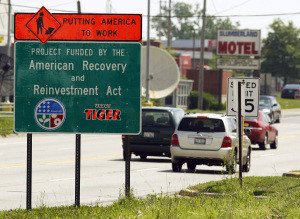 The American Recovery and Reinvestment Act was generally left to Congress to craft.Its size and shape didn't come from the Obama's administration but was left up to our representatives to make the dollar amounts and compromises according to Joe Stiglitz(Freefall).A well designed stimulus program should reflect seven principles according to Stiglitz.(1) It should be fast(Bush delayed and ignored the signs)(2) It should be effective(every dollar should give rise to a large increase in employment and output).(3)It should address the country's long term problems(huge trade deficits,decaying infrastructure,low national savings).(4)It should focus on investment(assets that increase the country's long- run productivity).(5)It should be fair(designed for the middle class not the upper class).(6)It should deal with the short-run exigencies created by the crisis(mortgage payments,health insurance,unemployment).(7)The stimulus should be targeted at areas of job loss(retraining workers for future jobs).
The American Recovery and Reinvestment Act was generally left to Congress to craft.Its size and shape didn't come from the Obama's administration but was left up to our representatives to make the dollar amounts and compromises according to Joe Stiglitz(Freefall).A well designed stimulus program should reflect seven principles according to Stiglitz.(1) It should be fast(Bush delayed and ignored the signs)(2) It should be effective(every dollar should give rise to a large increase in employment and output).(3)It should address the country's long term problems(huge trade deficits,decaying infrastructure,low national savings).(4)It should focus on investment(assets that increase the country's long- run productivity).(5)It should be fair(designed for the middle class not the upper class).(6)It should deal with the short-run exigencies created by the crisis(mortgage payments,health insurance,unemployment).(7)The stimulus should be targeted at areas of job loss(retraining workers for future jobs).The stimulus was less than three percent per year of GDP.About a fourth of the money($800 billion) would go out the first year.This amount,according to Stiglitz, was hardly enough to offset the cutbacks in spending at the state and local levels. To reduce unemployment,the economy had to grow faster than the baseline(3 to 4 %).Cumulative growth in 2009 and 2010,with the stimulus, was under 1.5% and that is a big shortfall. The fraction of the working- age population that was employed, 58.5%,was the lowest since 1947. By mid 2009, there were six unemployed workers for every vacancy--a record, and twice the number at the peak of the previous recession.
A few months of the passage of the stimulus bill,it became obvious,according to Stiglitz,that it had not been big enough.The contraction in consumption as savings increased,combined with cutbacks in state and local spending, meant the $800 billion wouldn't do the trick.Just offsetting the state revenue shortfall would require federal stimulus greater than 1% of GDP per year.The first priority should have been to make up for the shortfall of state revenues.In September 2009 alone, government employment went down by 40,000. Making up lost revenue,state by state,would have been fair and had high multipliers. The next priority should have been filling in the holes in the safety net.The loss of health insurance( many couldn't pay for COBRA) and the inability to pay mortgage payments damaged the recovery for numerous citizens.Mortgage insurance(government paying for those who can't) should have been part of the stimulus until people got back on their feet with a new job. Investments should have went to high return investments in people and in technology. Tax cuts,(30%) of the stimulus, and cash for clunkers tried to encourage citizens to consume more but we really needed that money for more investment for long-term growth.
The true measure of the stimulus is not the actual level of unemployment,but what unemployment would have been without the stimulus. Shock to the economy from the financial crisis was so bad that the stimulus wasn't enough.The Obama administration saved many jobs and stimulated the economy but Stiglitz and other economists feel it wasn't always the best responses and a clearer vision would have accomplished more .It was far better than any Republican response who undermined the stimulus when they negotiated with the Democrats before the act was finalized.
No comments:
Post a Comment